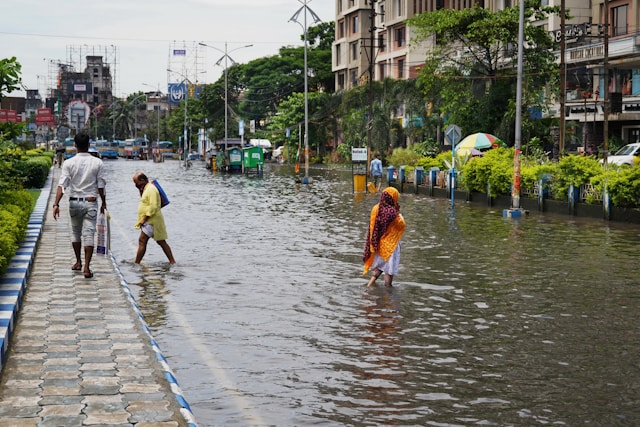Physical Address
23,24,25 & 26, 2nd Floor, Software Technology Park India, Opp: Garware Stadium,MIDC, Chikalthana, Aurangabad, Maharashtra – 431001 India
Physical Address
23,24,25 & 26, 2nd Floor, Software Technology Park India, Opp: Garware Stadium,MIDC, Chikalthana, Aurangabad, Maharashtra – 431001 India

A new study jointly released by IPE Global and Esri-India has revealed that over 85% of districts in India are prone to extreme climate events like floods, droughts, cyclones, and heatwaves. The study also revealed that, alarmingly, 45% of these districts are experiencing a “swapping trend,” where regions once prone to floods are now facing droughts, and vice versa. The research was unveiled at the Climate Technology Summit’s plenary session titled “Leveraging GIS Technology to Mitigate Climate Risks,” on Friday.
A Dramatic Rise in Climate Extremes
The study finds that the frequency, intensity, and unpredictability of climate extremes in India have surged four-fold in recent decades. This comprehensive analysis, which examines data from 1973 to 2023 using spatial and temporal modelling, provides a district-level assessment of the increasing threat posed by these events. The last decade alone has seen a five-fold increase in extreme climate events, indicating a worrying acceleration of environmental changes.
According to the report, India’s eastern, northeastern, and southern regions are particularly vulnerable to flooding, which has increased four-fold across the country. Greenhouse gas emissions, unsustainable land use, and unplanned development are fueling these changes. The study also notes a two-fold rise in droughts, particularly in southern states like Andhra Pradesh, Tamil Nadu, and Karnataka, as well as a four-fold increase in cyclones.
Abinash Mohanty, Head- Climate Change and Sustainability Practice at IPE Global and the author of the study, said, “The current trend of catastrophic climate extremes that makes 9 out 10 Indians exposed to extreme climate events are a resultant of 0.6 °C temperature rise in the last century. El Nino is gaining momentum and making its early presence felt across the globe with India facing the extreme events turbulence more in patterns than waves. Recent Kerala landslides triggered by incessant and erratic rainfall episodes, floods in Gujarat, disappearance of Om Parvat’s snow cover and the cities getting paralysed with sudden and abrupt downpour is a testament that climate is changed. Our analysis suggests that more than 1.47 billion Indians will be highly exposed to climate extremes by 2036 and these numbers peak of volumes. Embracing hyper-granular risk assessments and establish climate-risk observatories and infrastructure climate fund should become a national imperative to safeguard Indian economy especially for sensitive sectors like agriculture, industry, and large-scale infrastructural projects from the vagaries of climate change.”
Swapping Trends: A New Climate Reality
One of the most striking findings of the study is the discovery of swapping trends, where districts previously known for flood risks are now experiencing droughts. Districts like Srikakulum, Cuttack, Guntur, Kurnool, and others have seen this reversal. On the flip side, areas like Bengaluru Urban, Pune, Ahmedabad, Patna, and Prayagraj are among those experiencing an increase in flood-to-drought transitions.

Southern districts, especially in Andhra Pradesh and Tamil Nadu, are witnessing severe drought conditions, while regions like Rajkot, Surendranagar, Ajmer, and Jodhpur show vulnerability to both floods and droughts. Areas in Tripura, Kerala, Bihar, Punjab, and Jharkhand are also experiencing maximum swapping trends, further highlighting the complexity of India’s changing climate landscape, the study found.
Climate Change Drivers and Local Impacts
The study attributes much of this trend to microclimatic changes driven by local factors such as deforestation, land-use changes, and the encroachment on mangroves and wetlands. These factors have contributed to a 65% change in land-use and land-cover in climate hotspots, exacerbating the intensity of extreme events. The report emphasizes the urgent need to address these local drivers to mitigate future climate risks.
Key Recommendations
To combat these growing risks, the study recommends the establishment of a Climate Risk Observatory (CRO), a toolkit for decision-makers at national, state, district, and city levels. This CRO would provide data-driven insights to help manage and mitigate the impacts of extreme climate events. The researchers also suggest the creation of an Infrastructure Climate Fund (ICF), which would support investments in climate-resilient infrastructure and help markets adapt to increased risks.
This study underscores the need for a localized, hyper-detailed approach to climate risk assessment. The report argues that relying solely on global models is insufficient and that district-level assessments are essential for protecting lives, livelihoods, and economies. With climate change accelerating, the time for proactive and strategic action is now.
This groundbreaking research is a wake-up call, not just for policymakers but for all stakeholders involved in climate resilience. Addressing the dual threats of floods and droughts requires innovative solutions, investments in resilient infrastructure, and localized climate action strategies to safeguard India’s future.
References
https://www.esri.in/en-in/events/uc/agenda/delhi/climate-action-summit#registernow
Banner image: AI-generated
Photo by Dibakar Roy on Unsplash